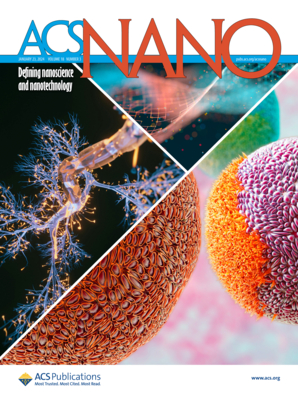IF 15.8
1区 材料科学
Q1 CHEMISTRY, MULTIDISCIPLINARY
引用次数: 0
摘要
克服肠上皮屏障以提高生物利用度是口服给药系统面临的一大挑战。理想的纳米载体应同时表现出快速的粘液渗透和高效的上皮吸收;然而,这两者通常需要相互矛盾的结构特性。在此,我们提出了一种通过改变源自大豆多肽的两亲纳米结构(SPNPs)的刚性来构建多性能纳米颗粒的策略,并以姜黄素(CUR)为模型货物,从体外和体内两方面考察了其克服多重障碍的能力。低刚性 SPNPs 与粘蛋白的亲和力较高,容易卡在粘液层中。当它们到达上皮细胞时,往往会通过clathrin和大蛋白胞吞途径被内吞,并进一步转移到溶酶体,表现出严重的降解和较低的姜黄素转运能力。颗粒硬度的增加通常会改善 CUR 的吸收,中等硬度的 SPNPs 可使 CUR 的最大血浆浓度增加 80.62 倍,口服生物利用度最高。单培养细胞和共培养细胞模型的结果表明,中等硬度的 SPNPs 受粘液层的影响最小,而硬度的变化会显著影响 SPNPs 的内吞和细胞内命运。刚度较高的 SPNPs 更倾向于通过洞穴介导的途径进行内吞,并迁移到 ER 和高尔基体,从而促进其整个转运过程,避免细胞内代谢。此外,刚性调节还能有效诱导细胞间紧密连接的可逆开放,从而协同改善 CUR 进入血液循环的运输。这项研究表明,对源于食物的两亲肽进行刚性调节可以克服多种生理障碍,作为口服给药的天然构件具有巨大的潜力。本文章由计算机程序翻译,如有差异,请以英文原文为准。

Mind the Particle Rigidity: Blooms the Bioavailability via Rapidly Crossing the Mucus Layer and Alters the Intracellular Fate of Curcumin
Overcoming intestinal epithelial barriers to enhance bioavailability is a major challenge for oral delivery systems. Desirable nanocarriers should simultaneously exhibit rapid mucus penetration and efficient epithelial uptake; however, they two generally require contradictory structural properties. Herein, we proposed a strategy to construct multiperformance nanoparticles by modifying the rigidity of amphiphilic nanostructures originating from soy polypeptides (SPNPs), where its ability to overcome multibarriers was examined from both in vitro and in vivo, using curcumin (CUR) as a model cargo. Low-rigidity SPNPs showed higher affinity to mucin and were prone to getting stuck in the mucus layer. When they reached epithelial cells, they tended to be endocytosed through the clathrin and macropinocytosis pathways and further transferred to lysosomes, showing severe degradation and lower transport of CUR. Increased particle rigidity generally improved the absorption of CUR, with medium-rigidity SPNPs bloomed maximum plasma concentration of CUR by 80.62-fold and showed the highest oral bioavailability. Results from monocultured and cocultured cell models demonstrated that medium-rigidity SPNPs were least influenced by the mucus layer and changes in rigidity significantly influenced the endocytosis and intracellular fate of SPNPs. Those with higher rigidity preferred to be endocytosed via a caveolae-mediated pathway and trafficked to the ER and Golgi, facilitating their whole transcytosis, and avoiding intracellular metabolism. Moreover, rigidity modulation efficiently induces the reversible opening of intercellular tight junctions, which synergistically improves the transport of CUR into blood circulation. This study suggested that rigidity regulation on food originated amphiphilic peptides could overcome multiple physiological barriers, showing great potential as natural building block toward oral delivery.
求助全文
通过发布文献求助,成功后即可免费获取论文全文。
去求助
来源期刊

ACS Nano
工程技术-材料科学:综合
CiteScore
26.00
自引率
4.10%
发文量
1627
审稿时长
1.7 months
期刊介绍:
ACS Nano, published monthly, serves as an international forum for comprehensive articles on nanoscience and nanotechnology research at the intersections of chemistry, biology, materials science, physics, and engineering. The journal fosters communication among scientists in these communities, facilitating collaboration, new research opportunities, and advancements through discoveries. ACS Nano covers synthesis, assembly, characterization, theory, and simulation of nanostructures, nanobiotechnology, nanofabrication, methods and tools for nanoscience and nanotechnology, and self- and directed-assembly. Alongside original research articles, it offers thorough reviews, perspectives on cutting-edge research, and discussions envisioning the future of nanoscience and nanotechnology.
 求助内容:
求助内容: 应助结果提醒方式:
应助结果提醒方式:


